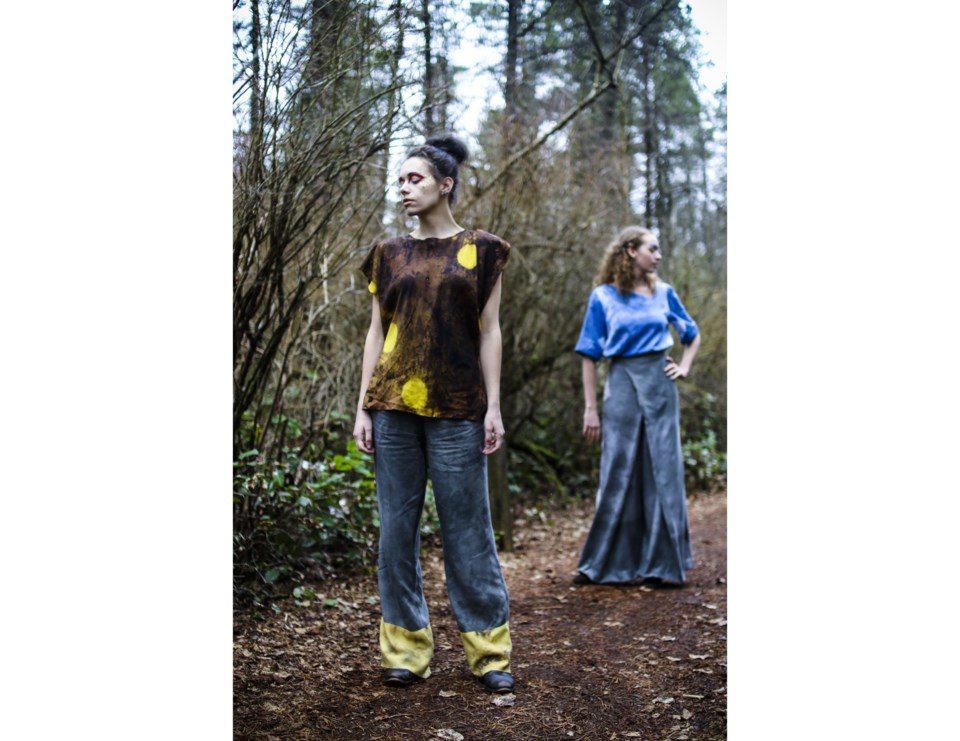Josie Robinson is trying to fashion a new way of working with clothes as she fashions a career path as well.
The 2012 D.P. Todd Secondary School grad is about to complete her degree in textile design at Kwantlen Polytechnic University in the Lower Mainland. Her final thesis is a line of original clothing in B.C.'s largest student fashion show and she has focused on more than just the look of the apparel. She also studied sustainability and ethics in relation to clothing and they are features of her garb as much as the aesthetic appeal.
"Clothing is very much a creative expression of identity," Robinson said. "Eterna (the name of her clothing line) wants to provide women with clothing that expresses their identity in an artistic way. In designing this collection I was also very cognizant of the negative impacts of cheap 'fast fashion'. I wanted to create something that a consumer would want to hang onto and cherish for a lifetime. That's why my collection rejects seasonal trends in favour of more timeless colour palettes and silhouettes."
So-called 'fast fashion' is a technique used in the clothing industry to pump out cheaply made, trendy clothing that is not in style for long, to be replaced next season by another wave of fast fashion, and then another six months later, and another, and another. It is cheap for the consumer to buy but also falls out of use quickly. Fast fashion can have negative manufacturing practices and low environmental regard.
"I want my designs to reject fast fashion. It will change with you throughout your life, become heirlooms, and continue to be sustainable," said Robinson. She achieves this by using natural dyes for colour, durable fabrics, flexibility to adjust to ever-changing body types over time, sewing techniques that maximize the strength of seams for those fabrics, few embellishments, and wearability that follows classic architectural lines for textiles.
"I am merging the worlds of fashion and fine art, and a lot of what I do is process-driven. I'm looking to help women who are active in their arts community and they want their clothing to reflect that," Robinson said. In this sense, it is clothing she would wear herself.
"I want to go into the artistic side of the clothing industry," she said. "I love more conceptual work. when I'm in the creative process, I'm looking to find a problem, solve that problem, and explore possible answers and outcomes. For myself, I find I over-research because I get caught up in the process. I could go into print design or textile design, generating the creative content, but I also recognize the importance of technical process, the manufacturing process. I'm interested in all these sides of fashion, not just one or two specialties."
Her passion for the art and business of clothing probably originates in the example set for her by her grandfather Bob Balcaen of McBride (a place she, too, has lived). Balcaen, she said, was always a passionate entrepreneur and community volunteer, serving many years on town council as well as other public service.
After going to younger grades in McBride, Burns Lake and at Quinson elementary school in Prince George, Robinson moved on to D.P. Todd where a pair of teachers, Tracy MacFarlane and Ian Leitch, inspired her to pursue this creative profession. Her parents were also supportive of her education choice despite it not being a conventional career.
"You start to ask, this is a huge industry. What is my place in that? What are the effects of this industry? We live in a world where we don't need any more clothes. Nobody needs me to make something cheap and pretty, so what is my role as a designer in this world? I grew up with parents who wanted us to value what we had, didn't want us to put ourselves above other people with the things we had, so I am pursuing this not out of vanity but out of the love of making things and sharing that with other people. I also learned to rework my own things as a teenager. That instilled in me the value of creativity, what hands can do, and the skills of making something last. I got into that early on."
Robinson is one of 32 students who will be showcased at the fashion show. She will be featured on the runway seven times over April 19-20. The show will take place inside Kwantlen's new $32-million purpose-built Wilson School of Design Building.
"In creating this collection, Robinson studied the traditional Japanese techniques of Shibori and Ijitame. She also tested and experimented extensively with plant-based dyes. Her pieces are dyed with natural indigo, turmeric, pomegranate and madder root," said Kwantlen spokesperson Tatiana Tomljanovic. "Robinson developed her line as part of her final thesis project before she graduates from (Kwantlen's) four-year fashion design and technology program this May. The program provides students with a rigorous studio-based design education. It teaches students both creative and technical skills to meet the demands of the global fashion industry. The capstone project involves extensive market and design research, requiring students to create garments that are empathetic to unique consumer needs."



